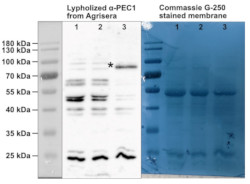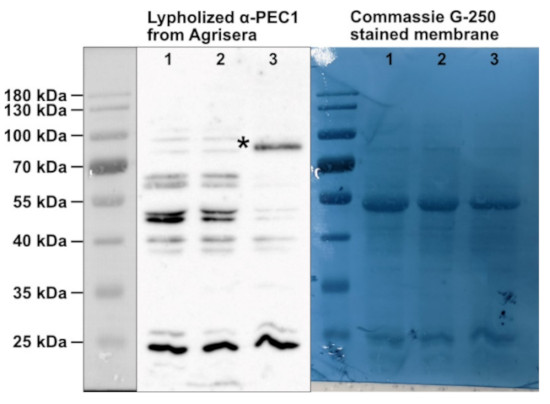1

Anti-PEC1 | Plastid Envelope Channel 1
AS21 4528 | Clonality: Polyclonal | Host: Rabbit | Reactivity: Arabidopsis thaliana
compartment marker of chloroplast envelope membrane
- Product Info
-
Immunogen: The soluble domain 466 (M244 until stop codon, ≈ 64 kDa) was cloned into pET16b and transformed into BLR 21 for 467 expression in Escherichia coli UniProt: Q8VZM7-1, TAIR: At5g02940 Host: Rabbit
Clonality: Polyclonal Purity: Serum Format: Lyophilized Quantity: 50 µl Reconstitution: For reconstitution add 50 µl, of sterile water Storage: Store lyophilized/reconstituted at -20°C; once reconstituted make aliquots to avoid repeated freeze-thaw cycles. Please remember to spin the tubes briefly prior to opening them to avoid any losses that might occur from material adhering to the cap or sides of the tube. Tested applications: Western blot (WB) Recommended dilution: 1 : 1000 (WB) Expected | apparent MW: 100 | 75 kDa - Reactivity
-
Confirmed reactivity: Arabidopsis thaliana Predicted reactivity: Camelina sativa, Capsella rubella, Nicotiana benthamiana, Noccaea caerulescens, Pisum sativum, Raphanus sativus,
Species of your interest not listed? Contact us - Application Examples
-

Samples:
1 – 2,5 ug of Arabidopsis thaliana mutant pec1-1pec2-1
2 – 2,5 ug of Arabidopsis thaliana mutant pec1-2pec2-2
3 – 2,5 ug of Arabidopsis thaliana whole leaf extract
Arabidopsis thaliana tissue was frozen with liquid nitrogen and ground to a fine powder with mortar and pestle. Protein was extracted by mixing with extraction buffer (200 mM tris pH 8.0, 4% (w/v) sodium dodecyl sulfate) to 0.5 g fresh weight/mL and heating at 80°C for 8 min. 5 µl protein extract were separated on 10 % SDS-PAGE and blotted at 75v for 45min to nitrocellulose (pore size of 20 um), using wet transfer. Blot was blocked with 5% milk for 1h/RT with agitation. Blot was incubated in the primary antibody at a dilution of 1: 1000 ON/4°C in 5% Milk-TBS-T with agitation. The antibody solution was decanted and the blot was rinsed briefly twice, then washed once for 15 min and 3 times for 5 min in TBS-T at RT with agitation. Blot was incubated in matching secondary antibody (anti-rabbit IgG horse radish peroxidase conjugated) diluted to 1:10 000 in for 1h/RT with agitation. The blot was washed as above and developed for 1 min with chemiluminescent detection reagent following manufacture's recommendations. Exposure time was 120 seconds.
Courtesy of Carsten Voelkner, Kunz Lab - Additional Information
-
Additional information: This antibody is recognizing PEC1, but not PEC2 or DMI1 - Background
-
Background: The two Arabidopsis POLLUX-like homologs PEC1 and PEC2 represent plastid envelope membrane cation channels with K + conductivity that are required for the stress triggered Ca 2+ release into the stroma. - Product Citations
-
Selected references: Völkner et al (2021) Two plastid POLLUX ion channel-like proteins are required for stress-triggered stromal Ca2+release, Plant Physiology, Volume 187, Issue 4, December 2021, Pages 2110–2125, https://doi.org/10.1093/plphys/kiab424
- Protocols
-
Agrisera Western Blot protocol and video tutorials
Protocols to work with plant and algal protein extracts
Agrisera Educational Poster Collection - Reviews:
-
This product doesn't have any reviews.
Accessories

AS05 084 | Clonality: Polyclonal | Host: Rabbit | Reactivity: [global antibody] for higher plants, algae, liverwort, cyanobacteria, diatoms | cellular [compartment marker] of thylakoid membrane
Benefits of using this antibody

AS06 122 | Clonality: Polyclonal | Host: Rabbit | Reactivity: C.reinhardtii, purple bacteria (CRD1) and plants (CHL27) including A.thaliana, H.vulgare, N. tabacum, P.sativum, P. patens, Synechocystis sp. PCC6803
compartment marker of chloroplast thylakoid and envelope membranes

